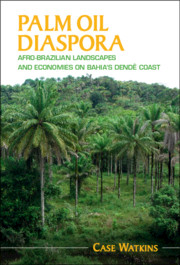Book contents
- Palm Oil Diaspora
- Afro-Latin America
- Palm Oil Diaspora
- Copyright page
- Contents
- Figures
- Tables
- Preface and Acknowledgments
- 1 Assembling an Afro-Brazilian Economy
- 2 African and Atlantic Worlds
- 3 Creolization
- 4 An Afro-Brazilian Landscape
- 5 South Atlantic Exchange
- 6 Landscapes, Religions, Transitions
- 7 Complexity
- Epilogue
- Bibliography
- Index
2 - African and Atlantic Worlds
Published online by Cambridge University Press: 20 May 2021
- Palm Oil Diaspora
- Afro-Latin America
- Palm Oil Diaspora
- Copyright page
- Contents
- Figures
- Tables
- Preface and Acknowledgments
- 1 Assembling an Afro-Brazilian Economy
- 2 African and Atlantic Worlds
- 3 Creolization
- 4 An Afro-Brazilian Landscape
- 5 South Atlantic Exchange
- 6 Landscapes, Religions, Transitions
- 7 Complexity
- Epilogue
- Bibliography
- Index
Summary
Weaving primary accounts with botanical and ecological analyses, this chapter demonstrates how oil palm cultures, landscapes, and commerce emerged in western Africa and eventually helped to integrate an Atlantic World. It details human-oil palm relationships in West and Central Africa over the previous five thousand years, and applies complexity sciences to understand the formation and proliferation of biodiverse palm groves permeating human communities and secondary forests. It places palm oil and kernels as early goods of trade on the inter-biome routes and later with European ships journeying down African coasts, and describes how palm oil supported the transatlantic slave trade as both provision and medicine. It culminates by charting the oil palm’s diffusion throughout the Caribbean and the mainland American Tropics during European colonial expansion. Charting the longue durée of African oil palms and their transatlantic diffusion, this chapter reveals how a promising model of human-environmental collaboration and ingenuity became subsumed in the transatlantic slave economy and its horrendous crimes against humanity.
Keywords
- Type
- Chapter
- Information
- Palm Oil DiasporaAfro-Brazilian Landscapes and Economies on Bahia's Dendê Coast, pp. 48 - 72Publisher: Cambridge University PressPrint publication year: 2021

